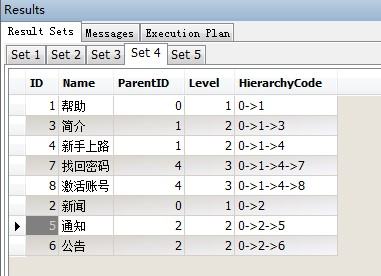一条sql语句顺序查询出父类的所有子类 如下图:用的是sql Server 2008
Posted
tags:
篇首语:本文由小常识网(cha138.com)小编为大家整理,主要介绍了一条sql语句顺序查询出父类的所有子类 如下图:用的是sql Server 2008相关的知识,希望对你有一定的参考价值。
id name parentId
1 帮助 0
2 新闻 0
3 简介 1
4 新手上路 1
5 通知 2
6 公告 2
7 找回密码 4
8 激活账号 4
。。。。。
要求查询出来时,结果为:
1 帮助 0
3 简介 1
4 联系方式 1
7 找回密码 4
8 激活账号 4
2 新闻 0
5 通知 2
6 公告 2
SQL 2005及以上可以使用CTE实现递归。
with tmp (ID,Name,ParentID,Level,HierarchyCode)as(
select ID,Name,ParentID,1,convert(varchar,convert(varchar,ParentID)+'->'+convert(varchar,ID))
from 表名 where ParentId=0 --已知根节点是0
UNION ALL
select a.ID,a.Name,a.ParentID,Level+1,convert(varchar,HierarchyCode+'->'+convert(varchar,a.ID))
from 表名 a inner join tmp b on a.ParentID=b.ID
)
select * from tmp order by HierarchyCode
结果如下:

需求一清楚了就好回答了
JavaSE复习_7 异常
public static int f(int n){ try{ int r =n *n ; return r ; } finally{ if(n ==2) return 6; } }
该语句当n=2时,返回6。
△try finally语句中,finally语句中如果关闭抛出了异常,那么后抛出的异常将会把刚抛出的异常给覆盖
class XyyException extends Exception{ public XyyException(String s ){ super(s ); } } class HlhException extends Exception{ public HlhException(String s ){ super(s ); } } public class Demo { public static void main(String[] args) throws XyyException, HlhException { f(); } public static void f() throws XyyException, HlhException { int x =2; try{ x= x*2; throw new XyyException("try"); } finally{ if(x ==4){ throw new HlhException("finally"); } } } }
Exception in thread "main" string.Demo.HlhException: finally at string.Demo.Demo.f( Demo.java:26) at string.Demo.Demo.main( Demo.java:15)
public static int f(){ int x=10; try{ System.out.println(12/0); return x; } catch(Exception e) { x=20; return x; } finally { x=30; if(x==30) return x; } }
这个代码finally会将return30,因为finally中的return会将catch中的return覆盖,而如果没有return x,则该方法返回20,因为x仅仅赋值,但是返回的此时已经确定好了值.即在finally语句在return执行后返回前执行。
import java.util.*; public class FinallyTest6 { public static void main(String[] args) { System.out.println(getMap().get("KEY").toString()); } public static Map<String, String> getMap() { Map<String, String> map = new HashMap<String, String>(); map.put("KEY", "INIT"); try { map.put("KEY", "TRY"); return map; } catch (Exception e) { map.put("KEY", "CATCH"); } finally { map.put("KEY", "FINALLY"); map = null; } return map; } }
这个代码运行结果是finally。因为在try中即返回了引用所指向的对象(即确定的是对象),随后对对象的操作都会改变返回值,但是在finally代码块的最后一句将引用指向空,对于对象不构成任何影响,原对象返回。
package io.project.one; import java.util.logging.FileHandler; import java.util.logging.Formatter; import java.util.logging.Level; import java.util.logging.LogRecord; import java.util.logging.Logger; public class Demo2 { public static void main(String[] args) { Logger logger=Logger. getLogger("io.project.one.Demo2"); logger.setLevel(Level. FINE); try { FileHandler fh= new FileHandler("MyLogger.txt" ); fh.setLevel(Level. FINE); fh.setFormatter( new MyFormatter()); logger.addHandler( fh); logger.fine( "进入main函数" ); int x =2; int y =3; add(x,y); logger.exiting( "io.project.one.Demo2", "main" ); } catch (Exception e ) { e.printStackTrace(); } } public static void add(int x, int y) { Logger logger=Logger. getLogger("io.project.one.Demo2"); logger.fine( "io.project.one.Demo2"); System. out.println("x+y" ); logger.fine( "io.project.one.Demo2"); } } class MyFormatter extends Formatter{ @Override public String format(LogRecord record ) { return "类别:" +record .getLevel()+"....信息:"+ record.getMessage(); } }
以上是关于一条sql语句顺序查询出父类的所有子类 如下图:用的是sql Server 2008的主要内容,如果未能解决你的问题,请参考以下文章